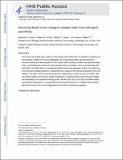Structural Basis of an N-Degron Adaptor with More Stringent Specificity
Author(s)
Stein, Benjamin Joseph; Grant, Robert A.; Sauer, Robert T.; Baker, Tania
Downloadnihms749560.pdf (2.404Mb)
PUBLISHER_CC
Publisher with Creative Commons License
Creative Commons Attribution
Terms of use
Metadata
Show full item recordAbstract
The N-end rule dictates that a protein's N-terminal residue determines its half-life. In bacteria, the ClpS adaptor mediates N-end-rule degradation, by recognizing proteins bearing specific N-terminal residues and delivering them to the ClpAP AAA+ protease. Unlike most bacterial clades, many α-proteobacteria encode two ClpS paralogs, ClpS1 and ClpS2. Here, we demonstrate that both ClpS1 and ClpS2 from A. tumefaciens deliver N-end-rule substrates to ClpA, but ClpS2 has more stringent binding specificity, recognizing only a subset of the canonical bacterial N-end-rule residues. The basis of this enhanced specificity is addressed by crystal structures of ClpS2, with and without ligand, and structure-guided mutagenesis, revealing protein conformational changes and remodeling in the substrate-binding pocket. We find that ClpS1 and ClpS2 are differentially expressed during growth in A. tumefaciens and conclude that the use of multiple ClpS paralogs allows fine-tuning of N-end-rule degradation at the level of substrate recognition.
Date issued
2016-01Department
Massachusetts Institute of Technology. Department of BiologyJournal
Structure
Publisher
Elsevier BV
Citation
Stein, Benjamin J. et al. “Structural Basis of an N-Degron Adaptor with More Stringent Specificity.” Structure 24, 2 (February 2016): 232–242 © 2016 Elsevier Ltd
Version: Author's final manuscript
ISSN
0969-2126
1878-4186